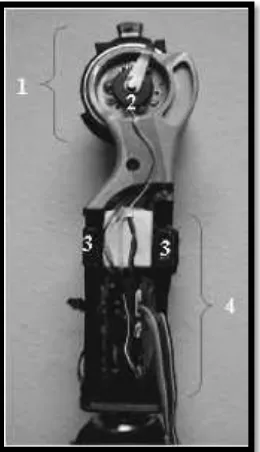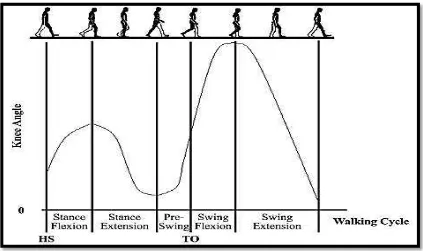DEVELOPMENT OF PROSTHETIC LEG USING MAGNETORHEOLOGICAL DAMPER
WAN NURAZRI BIN WAN BUKHARI
UNIVERSITI TEKNIKAL MALAYSIA MELAKA
R I B A C HE L OR OF M E C HANI C AL E NG. ( DE S IGN & I NNOVA T ION
) 2
0
1
5
UT
SUPERVISOR DECLARATION
“I hereby declare that I have read this thesis and in my opinion this thesis is sufficient in term of scope and quality for the award of the degree of Bachelor of Mechanical Engineering
(Design and Innovation)
Signature : ………
WAN NURAZRI BIN WAN BUKHARI
The thesis is presented in
Partial fulfilment of the requirements for the
Degree of Bachelor Mechanical Engineering (Design and Innovation)
Faculty of Mechanical Engineering Universiti Teknikal Malaysia Melaka
DECLARATION
“I hereby declare that the work in this thesis is my own except for summaries and quotations which have been duly acknowledged.”
Signature : ………
This dedication to my beloved parents, siblings and supervisor who encouraged me to finish my thesis during my study at Universiti Teknikal
ACKNOWLEDGEMENT
I want to take this opportunity to thank Allah for giving me a spirit and strength finished up the project and report for PSM. I would like to appreciate to those people that helped me and give some advice and guide in order to complete the PSM. I would like to express my appreciation and thanks to my only supervisor, Dr Mohd Khairi bin Mohamed Nor that who helped and guided me a lot throughout the semester. His experience on the various type of engineering problem had taught me the valuable knowledge and given me some moral boost of intellectual and confidence during the project.
I also would like to thank my parents and siblings for their support while conducting the project. My father and mother, Wan Bukhari bin Wan Mohamed and Zaiton binti Sulong respectively, who had been supporting and praying for my success in 4 years for my Degree at UTeM. My family alongside with my relatives had been supporting and praying for my success of this project.
ABSTRACT
ABSTRAK
TABLE OF CONTENT
CHAPTER TOPIC PAGE
DECLARATION ii
DEDICATION iii
ACKNOWLEDGEMENTS iv
ABSTRACT v
ABSTRAK vi
TABLE OF CONTENTS vii
LIST OF FIGURES ix
LIST OF TABLES xi
CHAPTER 1 INTRODUCTION 1
1.1 BACKGROUND 1
1.2 PROBLEM STATEMENT 2
1.2.1 Objective 4
1.2.2 Scope 4
1.2.3 Flow chart 5
CHAPTER 2 LITERATURE REVIEW 6
2.1 INTRODUCTION 6
2.2 PROSTHETIC LEG 7
2.3 HUMAN GAIT ANALYSIS 8
2.4 ABOVE KNEE PROSTHETIC LEG
(BK type) 13
2.6 MAGNETORHEOLOGICAL FLUID
(MR Fluid) 14
2.7 MAGNETORHEOLOGICAL DAMPER
(MR Damper) 14
2.8 MONO TUBE MR DAMPER 17
CHAPTER 3 METHODOLOGY 19
3.1 INTRODUCTION 19
3.2 HOUSE OF QUALITY (HoQ) 20
3.3 MORPHOLOGICAL CHART 21
3.4 WEIGHTED DECISION MATRIX
(WDM) 24
CHAPTER 4 RESULT AND ANALYSIS 29
4.1 INTRODUCTION 29
4.2 SELECTED DESIGN 30
4.3 DETAIL DRAWING 31
4.3.1 Design of the prosthetic leg 33
4.4 ASSEMBLY ANALYSIS 34
4.4.1 New design of the prosthetic leg 34
4.4.2 Additional design of the
prosthetic leg 37
CHAPTER 5 DISCUSSION 40
CHAPTER 6 CONCLUSION AND RECOMMEDATION 50
REFERENCES 52
LIST OF FIGURES
NO. TITLE PAGE
1.1 The existing prosthetic leg with MR Damper 3
2.1 Various types of prosthetic leg 7
2.2 Variable-damper knee prosthetic 8
2.3 Five basic movement of walking gait 9
2.4 The basic components of the AK prosthetic leg 10
2.5 The schematic diagram of the active AK prosthetic leg 11
2.6 The schematic diagram of the passive AK prosthetic leg 12
2.7 The Below Knee prosthetic leg 13
2.8 Schematic diagram of MR Damper 14
2.9 RD-1005- damper 15
2.10 RD-1097-1 damper 15
2.11 The testing of without and with MR Damper 16
2.12 Mono Tube MR Damper 17
with MR damper 24
3.3 The sketch of conceptual design 2 27
3.4 Sketch of conceptual design 2 in inclined plane 28
4.1 The selected conceptual design from PSM 1 30
4.2 (a) The isometric view of the prosthetic leg on the
CATIA software (b) The side view of the prosthetic leg. 31
4.3 (a) The isometric view of the prosthetic leg on the
SolidWork software (b) The side view of the prosthetic leg 32
4.4 (a) Isometric view of the full assembly of the prosthetic leg
(b) Side view of the full assembly of the prosthetic leg 33
4.5 Von Mises Stress result 34
4.6 Strain result 35
4.7 Deformation result 36
4.8 Von mises stress 37
4.9 Strain result 38
4.10 Deformation result 38
5.1 Simulation on the MR Damper movement 45
LIST OF TABLES
NO. TITLE PAGE
3.1 House of Quality Table 20
3.2 Morphological Chart 21
3.3 First conceptual design 22
3.4 Second conceptual design 22
3.5 Third conceptual design 23
3.6 Fourth conceptual design 23
3.7 WDM for concept 1 and 2 25
3.8 WDM for concept 3 and 4 26
5.1 Comparison of existing and new prosthetic leg 42
CHAPTER 1
INTRODUCTION
1.1 BACKGROUND
The new technology in the recent years had improved the lifestyle of the person in the daily life. For example, people nowadays used a various types of devices and gadgets such hand phones and tablets because of the demands throughout the world. Also in the medicine technology, there are many improvements nowadays especially for the handicapped person that also want their own demands to live as like as the normal person. The handicapped person also have a feeling as the normal person but living without one or more parts of the body. Amputations are the removal parts of the body which is enclosed by skin. This is happened when the person involved with accidents either at the work place, on the road or battlefield.
of prosthetic leg which is the Above Knee prosthetic leg (AK type), Below Knee prosthetic leg (BK type). The Above Knee prosthetic leg or AK type is leg that had been amputated of the missing the whole majority of the leg. BK type or the Below Knee prosthetic leg is amputated below the knee of the leg. Meanwhile, semi active prosthetic leg is the combination of the active and passive system of the prosthetic leg. The active prosthetic leg is the leg that is used the mechanism that can do a similar gait as the normal person walking. Most of the prosthetic leg are passive which is has no ability to adapt to the change of the environment. Active prosthetic leg can adapt with environment by using sensor which is controlled the actuator based on user response. The usage of the hydraulic actuator that been used to provide a swing gait of the walking manner. For the passive system, there are just a simple type with have not certainly functioned as the normal person gait. In recent years, there are many studies and researches to improve the prosthetic leg design and function to the exact natural gait of the normal person.
1.2 PROBLEM STATEMENT
suitable to use and cannot be tested to the amputees. The existing design needed a newer mechanism to ensure more efficient usage. The prosthetic leg needed to be redesign to improve the optimization and design in the new proper ways to overcome the problem and recreate the natural gait of the normal person in daily life.
i. To analyse the existing product of prosthetic leg using magnetorheological (MR) damper as actuator.
ii. To redesign the prosthetic leg to control two joints.
1.2.2 Scope
The scopes of this project are:
i. To study the existing MR prosthetic leg mechanism.
ii. To propose the improvement for the existing design.
iii. To design and optimize the MR damper prosthetic leg.
Studies of the previous research (Literature Review)
Start
Project planning
Preliminary design
(Redesign on the existing product)
Concept design
(Possible numbers of ideas and Morphological chart)
Analysis on prosthetic leg
Report Writing
End Detail design
CHAPTER 2
LITERATURE REVIEW
2.1 INTRODUCTION
Prosthetic leg can be classified as an artificial limb or fake leg that is attached to where the leg had been amputated due to disease and trauma such battlefield war and accidents. Nowadays, there are many types of prosthetic leg that had been produced in the market throughout the world to help the amputated person to have a life as usual as like the normal person as shown in Figure 2.1. There are three main components that are commonly found in prosthetic leg such as the socket, pylon and the suspension system or foot system.
Figure 2.1: Various types of prosthetic leg (biomed.brown.edu)
The socket of the prosthetic leg is the components that to ensure the joints between the residual limbs and the prosthetic socket. It is functioned as to optimize the proper fit but it must make by the custom made by the patient itself according to the shapes and the condition of the residual limb. Furthermore, it is ensure not to harm damage to the skin and causing irritation. The pylon is the common major component of the prosthetic leg that is the frame or skeleton that provide a structural support that usually used by using a metal materials. In recent years, there had been many development of upgrading into another material such as carbon fiber composites due to the lightweight properties.
2.3 HUMAN GAIT ANALYSIS
[image:22.595.253.383.402.628.2]The gait or a person‟s manner of walking is adapting on the knee damping from the gait of the amputees just by using a local sense of knee force, torque and position of the prosthetic leg. User adaptive knee is successfully controls the early stage of stance of the damping, which is undergo biological realistic of knee flexion. The damping must match with the requirement of the amputee‟s gait in form of walking speed, style and body size (Herr, H., Wilkenfeld, A., 2003).
Figure 2.2: Variable-damper knee prosthetic (Herr, H., Wilkenfeld, A.)
angle sensor (2), strain gauge sensors (3) and electronic board/battery.
[image:23.595.116.539.415.666.2]Figure 2.3 shows the pictogram of the walking gait of the human being. There are five basic movement of walking gait such stance flexion, stance extension, pre-swing, swing flexion and swing extension (Herr, H., Wilkenfeld, A., 2003). Firstly, the stance flexion is occurred when the knee stance begins to flex slightly for shock absorb as well as to keep the centre of gravity. Next movement is called stance extension. The situation when the knee stance is reached maximum flexion; the joint begins to extend again. Pre-swing or also called as “knee break” that is performed when the leg of the supporting leg begins to flex again in preparation for leaving the ground. Next, the swing flexion was happened when the hip flexed and the knee reached the angle, the leg leaves the ground and the knee continues to flex. Finally, the swing extension was happened when the knee begins to extend which is maximum flexion angle is at maximum during swing and the knee is in full extension and the next walking cycles begins.
which is used by the amputees that had been amputated the rest of the leg. It is also designed for the missing the majority of the leg. In medicine world, it is called a trans-femoral prosthetic leg. The fundamental common components for the prosthetic leg that is used are such as socket, foot, knee, thigh, hip joint and shank. But, this type of leg is more expensive than Below Knee prosthetic leg (BK type) because it is has more functions. Figure 2.4 shows the basic components of the AK prosthetic leg that is commonly used in the AK leg.

